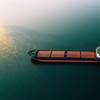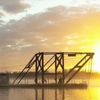Bulk Transport Leadership: Clark Todd
Drought and ensuing low river levels continue to affect the inland industry. Low water between St. Louis and Cairo, Illinois has threatened traffic on the Mississippi River since December.
For months, dredging operations have slowed vessels at points along the river's course. Since December, a stretch at Thebes, Illinois, has been shut for much of each day as the U.S. Army Corps of Engineers removes rock pinnacles. A panel of five executives weighed in on a host of topics regarding inland transportation as part of a round table discussion published in the February print edition of Marine News. Shown here are the comments of Clark Todd, President and COO at Blessey Marine Services, Inc. in New Orleans:
How have reduced Mississippi River drafts have affected your operations, safety, and your bottom line?
Clark Todd: Industry tried for months to get the U.S. Army Corps of Engineers or USACE to address the approaching, low-water situation on several fronts and with several options--all to no avail in anything that could be considered timely. As a vessel owner and operator of inland tank barges, Blessey Marine’s primary consideration is the safety of our crews, our equipment, the environment and local populations in areas where we operate. Reduced flow in the river and the emergence of rock formations and pinnacles created huge hazards to navigation along segments of our inland waterways. We have taken extra precautions in addressing these issues with our captains who operate above Cairo, Ill., and we have actively engaged our customers to ensure that all safety concerns are addressed during this low-water event. Stretches of the Mississippi River that are normally open for two-way traffic are only wide enough for one-tow, eliminating many meeting areas. Tows are losing time waiting for traffic to clear certain areas, thereby increasing transit times, sometimes by days. Tow groundings have occurred in these areas with greater frequency since the current, low-water event began. Each carrier company has different operating margins, different terms and conditions in contracts and different considerations that affect financial statements. Some carriers operate by affreightment rates dependent on the volume of cargo carried in each tow, while other carriers operate on term-charter rates. So it isn't easy or appropriate to comment on how low-river stages affect one operator or another.
Is the Army Corps doing enough to facilitate Mississippi River transport?
Todd: Many months ago, industry representatives began trying to present this issue to the attention of the USACE. The effects of the drought were a forecastable event that everyone knew would affect transportation throughout the Mississippi River Valley and certainly in and below the St. Louis area. Industry and the USACE knew that this day would come when the last major re-write of the USACE Master Operating Plan for the Missouri River was being debated years ago. Despite recent efforts by industry, the USACE punted the low-water issue around internally for a while. Its reaction was delayed even though industry cried for immediate action. The effects of the drought were heightened by two issues that could have provided a remedy to the problem. First, due to low water, significant numbers of rock formations and pinnacles emerged in the area north of Cairo, Ill., restricting navigable channels on parts of the Upper Mississippi River. And despite knowing the inevitable effects that low water would have in bringing these rock formations into play and their direct effect on navigation, the USACE waited until Dec. 11 of last year to award bids to two contractors to remove these impediments. Second, USACE should have released water from reservoirs on the Missouri River to maintain specific draughts along the Upper Mississippi. They refused, hid behind a public response that they couldn't do anything on the issue without Congressional intervention, and instead released somewhat insignificant amounts of water from other rivers. For months, navigable channels north of St. Louis have been pinched and vessel traffic has been limited to one-way transit--most of which industry believes could have been avoided if the USACE, as the custodian of America’s inland waterway, had taken appropriate and timely action. Lack of action by the USACE forced industry to mount a large, grassroots campaign involving U.S. Senators, Congressmen and other stakeholders, who in turn addressed the USACE at every level of its hierarchy, as well as President Obama.
Are inland freight rates adequate to cover operators' costs now?
Todd: Each carrier company has different operating margins, different terms and conditions for their contracts and different considerations that affect financial statements. It wouldn't be appropriate to comment further on this issue. But we can say that for carriers who operate on affreightment rates, being paid by the ton or barrel instead of a chartered day rate, those operators would be affected not only by limited draught, but also tow size, thereby limiting the amount of cargo per barge and the number of barges they're able to move. The ultimate impact could be more cargo moved by rail or truck or no movement of cargo at all, depending on the circumstances.
How will reduced barge traffic impact the national economy this winter? To what extent will rail and trucks be used instead of barges?
Todd: Commercial transportation along our waterways, while largely unwitnessed by much of America, is the nation's safest, most economically viable and environmentally friendly mode of transportation for dry and liquid cargoes. U.S. Trade Representative Ron Kirk recently stated that the nation has $9 billion in exports sitting on barges because that can't get down the Mississippi River as a result of the drought. He cited a critical need to look holistically at all infrastructure. According to the American Waterways Operators, a tow on the Upper Mississippi, Illinois and the Ohio Rivers typically moves fifteen barges, thereby resulting in a decrease of 255 tons in capacity for one tow with just one-inch of water loss. The typical dry cargo tow on the Lower Mississippi River pushes 30 to 45 barges, resulting in decreased capacity of up to 765 tons for just a one-inch loss of water. A typical inland barge can carry the same amount of dry cargo--agricultural or steel products--as 16 rail cars or 70 semi trailer trucks. And one tank barge can carry the same amount of liquid cargo-- fuels or chemicals, for example--as 46 rail cars or 144 semi trailer trucks. According to the Texas Transportation Institute and AWO, the estimated effect of low water to consumers and the volume of products potentially impacted in December and January is 7 million tons of agricultural products, worth $2.3 billion; 1.7 million tons of chemical products, worth $1.8 billion; 1.3 million tons of petroleum products, worth over $1.3 billion; 700,000 tons of crude oil, worth $534 million; and 3.8 million tons of coal valued at $192 million. The increased carbon footprint from the use of rail and trucks in lieu of barges is staggering. Whether spare capacity of rail and trucks even exists to fill the void in reduced barge traffic and whether cargo suppliers will seek to use rail and/or trucks remains to be seen. Many factors would have to be addressed--particularly whether terminals and petroleum facilities have sufficient tank capacity to hold petroleum products until an equivalent number of railcars or trucks could move that cargo.
How difficult will it be to comply with the impending Subchapter M rule? Will we see more consolidation within the industry because of it?
Todd: The Notice of Proposed Rulemaking or NPRM for Subchapter M was published in August 2011, and public comments were provided in December of that year. If Subchapter M were made a final rule today, with the USCG incorporating none of the changes or revisions that industry provided, there would be some challenges for small and large companies. But we're confident that industry gave the USCG enough supporting data to revise and rewrite some of the requirements that were included in the NPRM--specifically redundant steering requirements. The USCG suggested that a redundant steering system be located in the engine room of towing vessels. This is impracticable financially and also nearly impossible. The USCG was not clear on whether any vessels would be grandfathered under these rules, leaving industry to rely on assumptions at this juncture. For the most part, Blessey is positioned so that our operations would have little difficulty complying with most of the elements of the NPRM. Its Safety Management System requirements pose few challenges for our operations since we have a Management System in place. Our customer base has been pushing for this for years. So for us, it would be a seamless transition. Other portions of the NPRM, specifically some of the record-keeping requirements, wouldn't cause us great concern since most of them are incorporated in our Management System, or can be added easily. The vagueness of the NPRM left a lot open to interpretation, however. The USCG offered two options for companies to receive Certificates of Inspection for vessels: a Safety Management System route whereby third-party auditors verify compliance for the issuance of a Certificate of Inspection and a Coast Guard option whereby the USCG would inspect every vessel to verify compliance. We're concerned that it would be difficult for any company to comply with these proposed rules when operating outside of a Management System. In addition, USCG resources would be severely strained if it were to inspect every vessel, and given recent budget cuts within the USCG, its strains have gotten worse. We're confident that in the end, however, the USCG will listen to the concerns of industry and work with us as a partner--who wants nothing other than to make the industry as safe as possible. Once the Final Rule is published, there will be phased-in compliance. Therefore, it’s unlikely that we'll see a large number of consolidations early on. However, given the resource burdens of developing, implementing and managing a management system, there's no doubt that some smaller companies will find themselves overwhelmed when trying to comply with Subchapter M.
Is the inland industry prepared for increased traffic from the Panama Canal?
Todd: The question shouldn't be whether the inland industry is prepared for increased traffic. It should be are the ports of the Northern Gulf--including Houston, New Orleans, Mobile, and Tampa--and the ports of the Eastern U.S.--Miami, Savannah and Baltimore--prepared to accept deeper draught and height vessels? The inland industry will look to meet the increased cargo requirements of refiners and petrochemical facilities in transporting their products. However, the immediate bottleneck will most likely be whether ports have met the navigational and capacity issues to handle larger vessels, regardless of whether the vessels are tankers, bulk carriers or container carriers.











